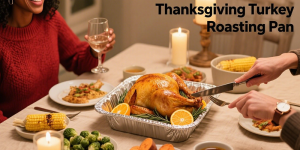Why Eat Turkey on Thanksgiving
Thanksgiving Day originated in 1620. At that time, a group of British Puritans arrived at the east coast of the United States during their exile. Back then, the land was wild and full of turkeys and other animals roaming around freely.
The Indians sent them turkeys and other food. The British wanted to thank the Indians who helped them in times of crisis and thank God for their “blessings”. Therefore, we hold such an event on the fourth Thursday of November every year.
In 1941, the US Congress made the fourth Thursday of November “Thanksgiving Day” every year. People closely associate Thanksgiving Day with roasted turkey.
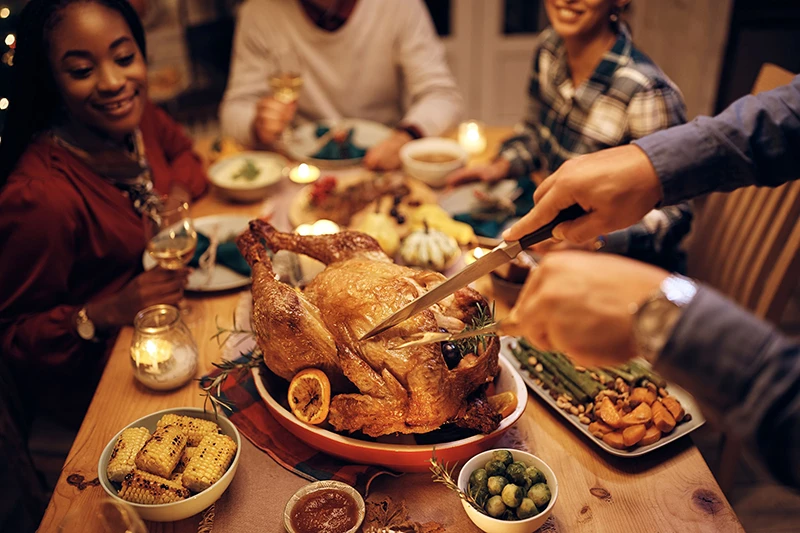
What Is The Best Turkey Roasting Pan
To roast the perfect Thanksgiving turkey, you must first learn to choose the right turkey pan.
- Stainless steel turkey pan: Stainless steel roasting pans are a great choice. They are durable, easy to clean, and can handle the weight of a large turkey. Choose a pan with sturdy handles and a V-shaped rack for ease of use. However, it is more expensive and conducts heat less well than aluminum foil turkey pans.
- Cast iron pan: Cast iron is an excellent conductor of heat, ensuring that the turkey cooks evenly. However, it is heavy, difficult to move, and more difficult to clean.
- Aluminum turkey pan: Aluminum pans for turkey are lightweight and affordable, making them a practical choice. They heat quickly and are disposable, so you don’t have to wash them after use. Some people worry that aluminum foil turkey pans are not durable, but just buy a heavy-duty disposable foil pan.
- Non-stick turkey pan: Non-stick pans have better non-stick properties, are durable, and cook evenly. However, non-stick turkey pans are usually more expensive, extremely fragile, and easily scratched by sharp objects. Some nonstick coating may not be suitable for use at high temperatures and may damage or produce harmful gases.
Do I Need to Cover the Roasting Turkey Pan
Roasting a turkey usually does not need a lid. Covering it will affect the taste of your turkey and sometimes heat it unevenly.
When roasting, keep the lid off to let heat circulate and make the turkey skin crispy. Leaving the lid uncovered also makes it easier for you to observe the cooking of the turkey.
When cooking a turkey, the oven must evaporate the moisture released by the turkey. This is necessary to ensure that the turkey roasts properly. The cover traps moisture, and using a lid will greatly affect the turkey’s taste and texture.
If the turkey’s skin is crispy but the inside still needs to cook, cover it with aluminum foil to keep the heat in. Aluminum foil can keep the turkey tender and moist inside, while preventing the skin from drying out.
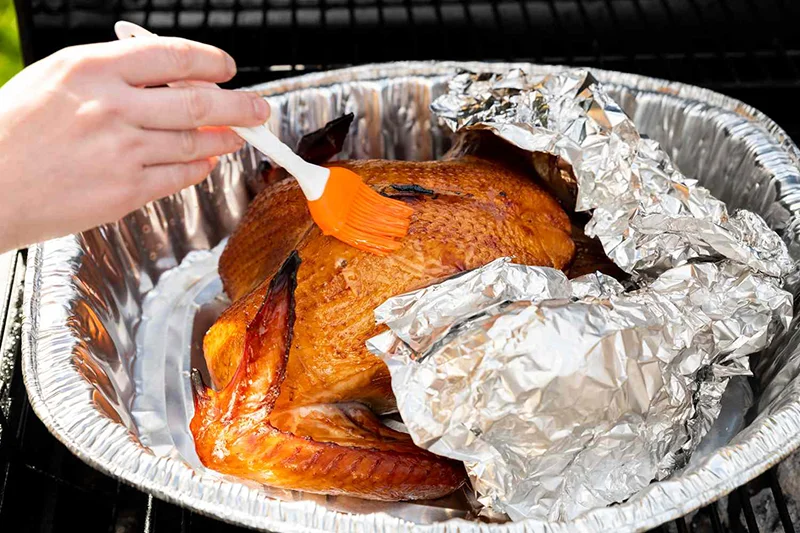
Do You Put Water in Turkey Pan
When cooking a turkey in a roasting pan, people often wonder if they should add water to the pan.
Some cooks add water to the bottom of the turkey pan to create steam, which keeps the turkey moist during cooking. The water in the bottom of the pan catches the drippings from the turkey, which you can use to make gravy. The water can help prevent the drippings from burning in the pan and causing smoke in the oven.
Some people don’t add water to the pan because it creates steam that stops the skin from getting crispy. Without the water, the drippings in the baking pan thicken more, providing a more flavorful base for the gravy.
Whether or not to add water depends on how you want your turkey to taste. For a juicy turkey, add water to the pan, but don’t cover the turkey completely. For a more flavorful turkey, skip the water altogether.
Tent Foil for Aluminum Foil Turkey Pan
Cover the turkey with foil in a disposable aluminum. This can prevent it from getting too brown or dry too fast.
Still, it will cook all the way through. It creates a small “tent” or dome over the turkey, reflecting heat and slowing the browning process. For example, if the breast starts to brown too much before the legs/thighs are well-roasted, cover it with foil.
Drape a piece of foil loosely over the turkey to form a dome shape, but don’t let it touch the turkey. You can secure the edges of the foil to the baking sheet to keep it in the “tent” shape.
How to Cook Turkey In Roaster Pan
| Ingredients for roast turkey: The weight of a turkey is usually about the same as the number of people who will be eating it. For example, if 18 people attend the banquet, the whole turkey is 18 pounds. Seasonings for roast turkey: Salt (garlic flavor), sugar, pepper, cumin powder, dried chili, soy sauce, grass powder, butter, coriander, etc. Specific steps: Thaw: After buying the turkey from the supermarket, thaw it in the refrigerator. To marinate the turkey, mix salt, sugar, pepper, and soy sauce in a ratio of 4:2:2:1. Add cumin powder, dried chili peppers, or other seasonings to taste. Stir well, coat the turkey with the mixture, and refrigerate overnight. Preparation: Remove the turkey from the fridge the day before. Melt the butter and spread it evenly all over the turkey. Sprinkle coriander on the chest, back, thighs, and wings of the turkey. Sprinkle salt and pepper evenly on the turkey. When everything is ready, wrap the turkey with tin foil. |
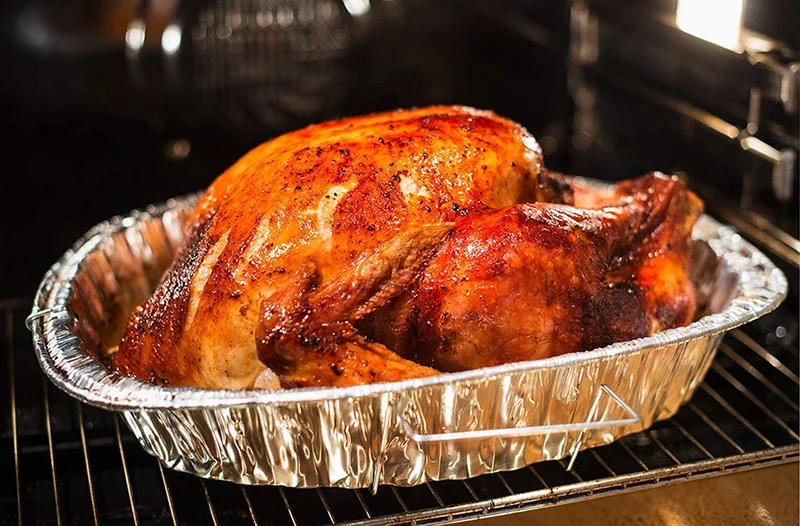
- Preheat the oven to 475 F, and when the temperature reaches the set value, put the turkey in the oven. Wait for 20 minutes.
- After 20 minutes at 475 F, reduce the temperature to 275 F and bake slowly at low temperature. The baking time is based on the weight of the turkey, and it takes about 20 minutes to bake 1 pound. For an 18-pound turkey, the baking time is 360 minutes, or 6 hours.
- While roasting, remove the turkey every 2 hours, pour the pan juices over it, and then return it to the oven to keep cooking.
- After 6 hours, take the turkey out of the oven, remove the tin foil, and roast at 350 F for 30 minutes. Make sure to pour juice twice during the process.
- After 30 minutes, take out the turkey and wait for 15-20 minutes before cutting.
Traditional Turkey Rack for Roasting Pan Grilling Tips
Brine:2 tablespoons canola oil 12 ounces chicken wings, halved at the joint 1 turkey neck, 1/4 cup diced carrots 1/4 cup diced celery
1/4 cup diced onion 1/2 cup red wine 1 tablespoon soy sauce 1/2 tablespoon salt, 3 allspice berries 3 cloves garlic, crushed
2 whole cinnamon sticks 2 sprigs fresh marjoram 2 sprigs fresh thyme
Ingredients for the recipe include a fresh turkey, salt, pepper, marjoram, sage, rosemary, green apples, Spanish onion, and garlic. The turkey should weigh 14–16 pounds. Season the turkey with 2 teaspoons of salt and 20 grinds of pepper. Stuff the turkey with the marjoram, sage, rosemary, apples, onion, and garlic.
To make herb mayonnaise, mix 2 egg yolks with 1 tablespoon of Dijon mustard. Slowly add 2 cups of canola oil while whisking. Stir in chopped fresh marjoram, sage, and thyme, along with juice from 1/2 orange. Season with salt and pepper.
To make herb mayonnaise, mix 2 egg yolks with 1 tablespoon of Dijon mustard. Slowly add 2 cups of canola oil while whisking. Stir in chopped fresh marjoram, sage, and thyme, along with juice from 1/2 orange. Season with salt and pepper.

- For the brine: In a large Dutch oven or soup pot, heat the oil over medium-high heat. Add the chicken wings and turkey neck, stirring occasionally, until dark brown and toasted, about 10 minutes.
- Add the carrots, celery, and onion and continue to cook until golden, 5 to 7 minutes more. Add the wine, scraping the bottom of the pot with a wooden spoon to release any bits.
- Add 1 quart of cold water, the soy sauce, salt, allspice, garlic, cinnamon, marjoram, and thyme. Bring to a boil. After the liquid has boiled for 5 minutes, stir well and cool over an ice bath.
- Strain out the solids and set aside.
- For the turkey: Place the brine and turkey in a brining bag and seal. Before cooking, let the turkey soak in the refrigerator for 12 hours.
- Rinse the turkey to remove excess brine and pat dry with a towel. Reserve about 1/2 cup of the brine for basting. Let the turkey sit, uncovered, at room temperature for 1 to 1 1/2 hours.
- Place a rack in the lower third of the oven and preheat to 425 degrees F.
- Place the reserved brine solids in the bottom of a roasting pan. Then place the rack on the solids.
- Sprinkle the turkey cavity with salt and pepper. Place the marjoram, sage, rosemary, apple, onion, and garlic in the cavity. Truss the turkey with kitchen twine. Evenly baste the turkey with the herb mayonnaise, using more if desired.
- Place the turkey, breast side up, on a rack in the roasting pan and roast for 30 minutes. Lower the oven temperature to 325 degrees F and continue roasting for 1 1/2 hours. Baste the meat with the drippings and brine every 15 minutes using a pastry brush. Continue roasting until an instant-read thermometer inserted into the thigh registers 165 degrees F.
- Total roasting time should be 3 to 3 1/2 hours. Remove the turkey from the oven and let rest for about 15 minutes. Cut and discard the kitchen twine and carve. Serve with gravy.
How Long To Grill Turkey Legs In Foil
When grilling turkey legs wrapped in foil, you should generally grill them over medium heat for about 1 hour. It’s recommended to turn the legs after 30 minutes to ensure even cooking. Wrapping turkey legs in foil helps retain moisture and flavor during the cooking process.
Cooking time may vary depending on the temperature of your grill and the size of your turkey legs.
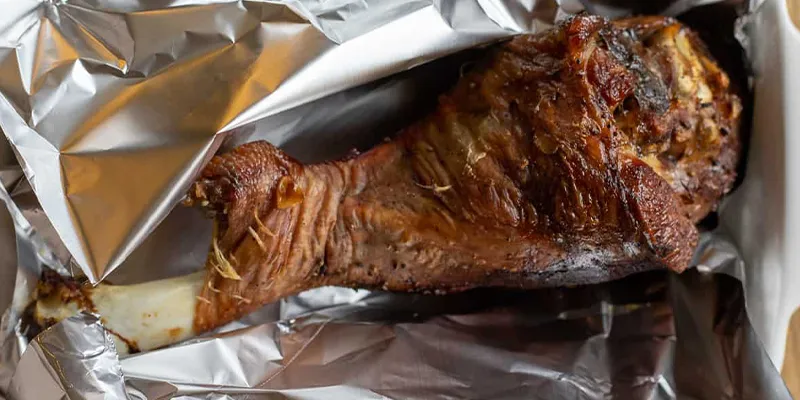
Grilling turkey legs requires you to preheat the grill to about 175℃. During this time, you can prepare your favorite seasonings and evenly coat the turkey legs. Then lay the heavy-duty aluminum foil flat on the table, place the turkey leg on the aluminum foil, and wrap the turkey leg tightly. Then put the wrapped chicken leg on the grill and grill the turkey leg for about 1.5-2 hours. You must keep a close eye on it to avoid accidents.
At the end of the grilling time, you can use a meat thermometer to check the thickest part of the turkey leg. As long as it reaches the normal cooked temperature, you can enjoy the food.
Some people like to wrap their smoked turkey legs in foil before putting them in the oven, which gives them a smoky, barbecue flavor. Wrapping them in foil will help the smoked turkey legs retain their moisture.
If you like a crispy skin, open the aluminum foil directly and place the turkey leg directly on the fire for the last 5-10 minutes of grilling. This will make the skin crispy and golden.
When To Put Foil On Turkey
When to put foil on the turkey depends on the cooking method you use (oven roasting, grilling, or smoking) and the result you want to achieve (crispy skin and tender meat).
If you want crispy skin, leave the turkey uncovered for the first stage of roasting. Roast the turkey at 325°F (163°C) for the first 2 to 2.5 hours, depending on the size of the turkey.
If the skin starts to darken too quickly, or if the breast roasts faster than the rest of the bird, loosely cover the turkey with foil. This prevents the skin from burning while allowing the meat to cook through.
For crispier and more golden skin, remove the foil during the last 30 to 45 minutes of roasting. This allows the skin to get very crispy and golden.
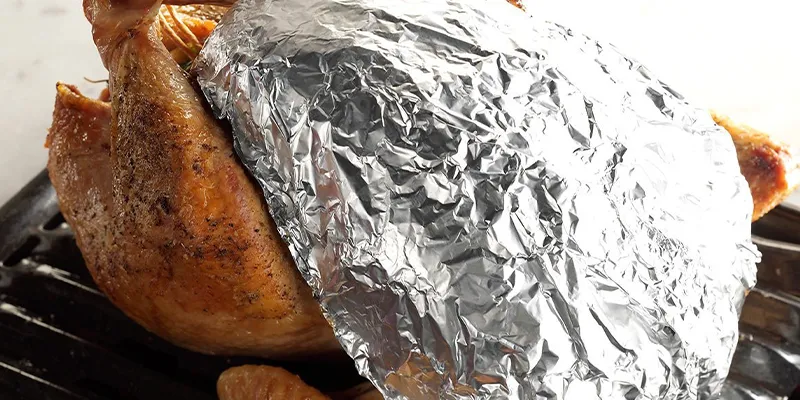
General Guidelines for Roasting a Turkey:
- Uncovered: First 2 to 2.5 hours (to crisp the skin).
- Cover: After the first 2.5 hours, loosely cover the turkey with foil if the skin is getting too dark.
- Uncover again: The last 30-45 minutes to crisp up the skin.
For a whole turkey, cover the bird with foil for the first 1 to 1.5 hours of grilling. After that, uncover the turkey to allow the skin to crisp up and continue grilling until the internal temperature reaches 165°F (74°C).
When smoking a turkey, it can dry out if the lid is left on throughout the cooking process. To retain moisture, loosely wrap the turkey in foil after 3-4 hours of smoking. This helps retain the smoky flavor while ensuring the meat remains tender and juicy. As with roasting and grilling, you should unwrap the turkey in the last 30 minutes to an hour of smoking. This allows the skin to brown and crisp up.
For turkey legs or breasts, you can wrap them in foil at the beginning of cooking, especially if you are grilling or roasting them. Unwrap the turkey parts after about half to two-thirds of the cooking time to allow the skin to crisp up.
If you want a very crispy skin or want your turkey to achieve maximum browning, don’t cover the turkey with foil until the very end. This is especially true if you’re roasting a smaller turkey or using a high-heat oven or fast-cooking grill.


